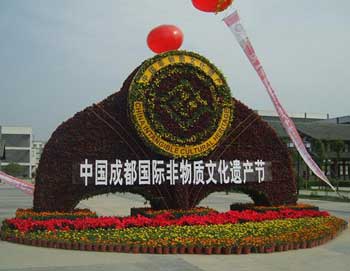Source: chinaculture.org
05-23-2007 15:45
 |
The National Intangible Cultural Heritages Park is now open to the public today. Yesterday, the reporter visited the park for the readers in advance, and would like to give a brief introduction to the park here.
Shining point (1): Jinsha sunbird greets visitors
At the two intersections leading to the park, visitors can feel the theme of the park through two huge sculptures. At the Tulong Road entrance, there is a huge sunbird logo sculpture standing on a bronze tripod caldron shaped like the Chinese character “非”, which means that the intangible cultural heritages of China are rich and colorful. While at the Lianghe Road entrance, two house-shaped gates characteristic of the ancient Chinese culture are erected. In addition, there are tens of characteristic sculptures reflecting folk customs both at home and abroad. Sculptures reflecting Chinese folk customs include the threesome waistdrum in northern Shaanxi Province, the water-splashing festival of Dai ethnic minority, the pounding of cooked glutinous rice into paste, and the foursome Tibetan dance. Sculptures reflecting foreign culture are mainly statues of the ancient Grecian and Roman celebrities including Gaius Octavianus, and Julius Caesar.
Shining point (2): Small Chinese town
While entering the park from the Lianghe Road entrance, visitors can see an ancient memorial archway, and then a small typical Chinese town, which is one of the important scenic spots in the park. The small Chinese town is the main venue of the fair of the intangible heritages festival. More than one hundred two-storey antique Chinese buildings are centralized here. The intangible cultural heritage projects from across China will be displayed free of charge in the exhibition spaces for half a month. In addition, there is also a traditional food exhibition area in the small Chinese town.
